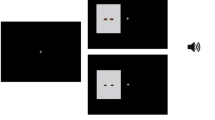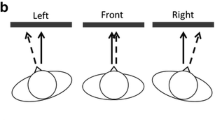Abstract
Others’ gaze direction and traffic arrow signal lights play significant roles in guiding observers’ attention in daily life. Previous studies have shown that gaze and arrow cues can direct attention to the cued location. However, it is ambiguous where gaze and arrow cues guide attention: the cued location or a broader cued region. Therefore, the present study adopted a primary cue-target task and manipulated possible target locations to explore this issue. The results revealed that due to the different physical characteristics of non-predictive gaze and arrow cues, physically unfocused-pointing gaze cues guided attention to a broader cued region, whereas focused-pointing arrow cues guided attention to the exact cued location. Furthermore, gaze cues could also direct attention to the exact cued location when observers’ attention was focused in a top-down manner (with highly predictive probability). These findings suggest that where gaze and arrow cues direct attention depends on whether observers’ attention is focused by the cues, either in a bottom-up or top-down manner. Accordingly, a preliminary framework called the “Focused-Diffused Attentional Orienting Model” is proposed to explain how gaze and arrow cues direct humans’ attention. The present study enhances our understanding of human attentional orienting systems from a behavioral perspective.





Similar content being viewed by others
Data and code availability
The data and the codes are available from the corresponding authors on reasonable request.
References
Bao, H.-W.-S. (2022). bruceR: broadly useful convenient and efficient r functions. R package version 0.8.x. https://CRAN.R-project.org/package=bruceR.
Baron-Cohen, S. (1997). Mindblindness: An essay on autism and theory of mind. MIT Press.
Callejas, A., Shulman, G. L., & Corbetta, M. (2014). Dorsal and ventral attention systems underlie social and symbolic cueing. Journal of Cognitive Neuroscience, 26(1), 63–80. https://doi.org/10.1162/jocn_a_00461
Campbell, J. I., & Thompson, V. A. (2012). MorePower 6.0 for ANOVA with relational confidence intervals and Bayesian analysis. Behavior Research Methods, 44(4), 1255–1265. https://doi.org/10.3758/s13428-012-0186-0
Capozzi, F., & Ristic, J. (2018). How attention gates social interactions. Annals of the New York Academy of Sciences, 1426(1), 179–198. https://doi.org/10.1111/nyas.13854
Cazzato, V., Macaluso, E., Crostella, F., & Aglioti, S. M. (2012). Mapping reflexive shifts of attention in eye-centered and hand-centered coordinate systems. Human Brain Mapping, 33, 165–178. https://doi.org/10.1002/hbm.21202
Driver, J., Davis, G., Ricciardelli, P., Kidd, P., Maxwell, E., & Baron-Cohen, S. (1999). Gaze perception triggers reflexive visuospatial orienting. Visual Cognition, 6(5), 509–540. https://doi.org/10.1080/135062899394920
Egly, R., Driver, J., & Rafal, R. D. (1994). Shifting visual attention between objects and locations: Evidence from normal and parietal lesion subjects. Journal of Experimental Psychology: General, 123(2), 161–177. https://doi.org/10.1037/0096-3445.123.2.161
Emery, N. J. (2000). The eyes have it: The neuroethology, function and evolution of social gaze. Neuroscience and Biobehavioral Reviews, 24(6), 581–604. https://doi.org/10.1016/s0149-7634(00)00025-7
Engell, A. D., Nummenmaa, L., Oosterhof, N. N., Henson, R. N., Haxby, J. V., & Calder, A. J. (2010). Differential activation of frontoparietal attention networks by social and symbolic spatial cues. Social Cognitive and Affective Neuroscience, 5(4), 432–440. https://doi.org/10.1093/scan/nsq008
Eriksen, C. W., & Yeh, Y. Y. (1985). Allocation of attention in the visual field. Journal of Experimental Psychology: Human Perception and Performance, 11(5), 583–597. https://doi.org/10.1037/0096-1523.11.5.583
Friesen, C. K., & Kingstone, A. (1998). The eyes have it! Reflexive orienting is triggered by nonpredictive gaze. Psychonomic Bulletin & Review, 5(3), 490–495. https://doi.org/10.3758/BF03208827
Friesen, C. K., Ristic, J., & Kingstone, A. (2004). Attentional effects of counterpredictive gaze and arrow cues. Journal of Experimental Psychology: Human Perception and Performance, 30(2), 319–329. https://doi.org/10.1037/0096-1523.30.2.319
Frischen, A., Bayliss, A. P., & Tipper, S. P. (2007). Gaze cueing of attention: Visual attention, social cognition, and individual differences. Psychological Bulletin, 133(4), 694–724. https://doi.org/10.1037/0033-2909.133.4.694
Frischen, A., & Tipper, S. P. (2004). Orienting attention via observed gaze shift evokes longer term inhibitory effects: Implications for social interactions, attention, and memory. Journal of Experimental Psychology: General, 133, 516–533. https://doi.org/10.1037/0096-3445.133.4.516
Greene, D. J., & Zaidel, E. (2011). Hemispheric differences in attentional orienting by social cues. Neuropsychologia, 49(1), 61–68. https://doi.org/10.1016/j.neuropsychologia.2010.11.007
Gregory, N. J., Hermens, F., Facey, R., & Hodgson, T. L. (2016). The developmental trajectory of attentional orienting to socio-biological cues. Experimental Brain Research, 234, 1351–1362. https://doi.org/10.1007/s00221-016-4627-3
Gregory, N. J., & Hodgson, T. L. (2012). Giving subjects the eye and showing them the finger: Socio-biological cues and saccade generation in the anti-saccade task. Perception, 41, 131–147. https://doi.org/10.1068/p7085
Hermens, F., Bindemann, M., & Burton, A. M. (2017). Responding to social and symbolic extrafoveal cues: Cue shape trumps biological relevance. Psychological Research: Psychologische Forschung, 81(1), 24–42. https://doi.org/10.1007/s00426-015-0733-2
Hietanen, J. K., Nummenmaa, L., Nyman, M. J., Parkkola, R., & Hamalainen, H. (2006). Automatic attention orienting by social and symbolic cues activates different neural networks: An fMRI study. NeuroImage, 33(1), 406–413. https://doi.org/10.1016/j.neuroimage.2006.06.048
Hommel, B., Pratt, J., Colzato, L., & Godijn, R. (2001). Symbolic control of visual attention. Psychological Science, 12(5), 360–365. https://doi.org/10.1111/1467-9280.00367
Hughes, H. C., & Zimba, L. D. (1985). Spatial maps of directed visual attention. Journal of Experimental Psychology: Human Perception and Performance, 11(4), 409–430. https://doi.org/10.1037//0096-1523.11.4.409
Hughes, H. C., & Zimba, L. D. (1987). Natural boundaries for the spatial spread of directed visual attention. Neuropsychologia, 25(1A), 5–18. https://doi.org/10.1016/0028-3932(87)90039-x
Jonides, J. (1981). Voluntary versus automatic control over the mind’s eye’s movement. Attention and Performance, 9, 187–203.
Joseph, R. M., Fricker, Z., & Keehn, B. (2015). Activation of frontoparietal attention networks by non-predictive gaze and arrow cues. Social Cognitive and Affective Neuroscience, 10(2), 294–301. https://doi.org/10.1093/scan/nsu054
Langton, S. R. H., & Bruce, V. (1999). Reflexive visual orienting in response to the social attention of others. Visual Cognition, 6(5), 541–567.
Langton, S. R. H., & Bruce, V. (2000). You must see the point: Automatic processing of cues to the direction of social attention. Journal of Experimental Psychology: Human Perception and Performance, 26(2), 747–757. https://doi.org/10.1037//0096-1523.26.2.747
Langton, S. R. H., Watt, R. J., & Bruce, V. (2000). Do the eyes have it? Cues to the direction of social attention. Trends in Cognitive Sciences, 4(2), 50–59. https://doi.org/10.1016/s1364-6613(99)01436-9
Lockhofen, D. E. L., Gruppe, H., Ruprecht, C., Gallhofer, B., & Sammer, G. (2014). Hemodynannic response pattern of spatial cueing is different for social and symbolic cues. Frontiers in Human Neuroscience, 8, 912. https://doi.org/10.3389/fnhum.2014.00912
Marotta, A., Lupianez, J., Martella, D., & Casagrande, M. (2012). Eye gaze versus arrows as spatial cues: Two qualitatively different modes of attentional selection. Journal of Experimental Psychology: Human Perception and Performance, 38(2), 326–335. https://doi.org/10.1037/a0023959
Muller, H. J., & Rabbitt, P. M. (1989). Reflexive and voluntary orienting of visual attention: Time course of activation and resistance to interruption. Journal of Experimental Psychology: Human Perception and Performance, 15(2), 315–330. https://doi.org/10.1037/0096-1523.15.2.315
Nummenmaa, L., & Calder, A. J. (2009). Neural mechanisms of social attention. Trends in Cognitive Sciences, 13(3), 135–143. https://doi.org/10.1016/j.tics.2008.12.006
Nummenmaa, L., & Hietanen, J. K. (2009). How attentional systems process conflicting cues. The superiority of social over symbolic orienting revisited. Journal of Experimental Psychology: Human Perception and Performance, 35(6), 1738–1754. https://doi.org/10.1037/a0016472
Okamoto-Barth, S., & Kawai, N. (2006). The role of attention in the facilitation effect and another “inhibition of return.” Cognition, 101, B42-50. https://doi.org/10.1016/j.cognition.2005.11.002
Posner, M. I. (1980). Orienting of attention. Quarterly Journal of Experimental Psychology, 32(1), 3–25. https://doi.org/10.1080/00335558008248231
Pratt, J., & Hommel, B. (2003). Symbolic control of visual attention: The role of working memory and attentional control settings. Journal of Experimental Psychology: Human Perception and Performance, 29(5), 835–845. https://doi.org/10.1037/0096-1523.29.5.835
R-Core-Team. (2021). R: A Language and Environment for Statistical Computing. R Foundation for Statistical Computing, Vienna, Austria. https://www.R-project.org/.
Ristic, J., Friesen, C. K., & Kingstone, A. (2002). Are eyes special? It depends on how you look at it. Psychonomic Bulletin & Review, 9(3), 507–513. https://doi.org/10.3758/bf03196306
Ristic, J., & Kingstone, A. (2006). Attention to arrows: Pointing to a new direction. Quarterly Journal of Experimental Psychology, 59(11), 1921–1930. https://doi.org/10.1080/17470210500416367
Ristic, J., Wright, A., & Kingstone, A. (2007). Attentional control and reflexive orienting to gaze and arrow cues. Psychonomic Bulletin & Review, 14(5), 964–969. https://doi.org/10.3758/bf03194129
Sato, W., Kochiyama, T., Uono, S., & Yoshikawa, S. (2009). Commonalities in the neural mechanisms underlying automatic attentional shifts by gaze, gestures, and symbols. NeuroImage, 45(3), 984–992. https://doi.org/10.1016/j.neuroimage.2008.12.052
Schauberger, P., & Walker, A. (2021). openxlsx: read, write and edit xlsx files. R package version 4.2.4. https://CRAN.R-project.org/package=openxlsx.
Stephenson, L. J., Edwards, S. G., & Bayliss, A. P. (2021). From gaze perception to social cognition: the shared-attention system. Perspectives on Psychological Science, 16(3), 553–576. https://doi.org/10.1177/1745691620953773
Stevens, S. A., West, G. L., Al-Aidroos, N., Weger, U. W., & Pratt, J. (2008). Testing whether gaze cues and arrow cues produce reflexive or volitional shifts of attention. Psychonomic Bulletin & Review, 15(6), 1148–1153. https://doi.org/10.3758/PBR.15.6.1148
Tipples, J. (2002). Eye gaze is not unique: Automatic orienting in response to uninformative arrows. Psychonomic Bulletin & Review, 9(2), 314–318. https://doi.org/10.3758/bf03196287
Wickham, H., Averick, M., Bryan, J., Chang, W., McGowan, L., François, R., & Yutani, H. (2019). Welcome to the tidyverse. Journal of Open Source Software. https://doi.org/10.21105/joss.01686
Wickham, H., & Bryan, J. (2019). readxl: Read Excel Files. R package version 1.3.1. https://CRAN.R-project.org/package=readxl.
Wiese, E., Zwickel, J., & Muller, H. J. (2013). The importance of context information for the spatial specificity of gaze cueing. Attention Perception & Psychophysics, 75(5), 967–982. https://doi.org/10.3758/s13414-013-0444-y
Acknowledgements
This research was supported by the Young Talent Fund of University Association for Science and Technology in Shaanxi, China (20210206) and the Humanity and Social Science Youth Foundation of the Ministry of Education of China (22YJC190030).
Author information
Authors and Affiliations
Contributions
Conceptualization: TZ, JZ, YW. Methodology: TZ, JZ, YW. Software: TZ, ZC. Formal analysis: TZ, YG. Investigation: TZ, YG, SH, LX, ZC, YT. Data curation: TZ, SH. Visualization: TZ, YG, LX. Writing-original draft: TZ. Writing-review & editing & supervision: JZ, YW.
Corresponding authors
Ethics declarations
Conflict of interest
The authors have no competing interests to disclose.
Ethical approval
This study was performed in line with the Principles of the Declaration of Helsinki. Approval was granted by the Ethics Committee of the School of Psychology, Shaanxi Normal University (Approval No. HR 2021-03-011).
Informed consent
Informed consent was obtained from all individual participants included in the study.
Additional information
Publisher's Note
Springer Nature remains neutral with regard to jurisdictional claims in published maps and institutional affiliations.
Rights and permissions
Springer Nature or its licensor (e.g. a society or other partner) holds exclusive rights to this article under a publishing agreement with the author(s) or other rightsholder(s); author self-archiving of the accepted manuscript version of this article is solely governed by the terms of such publishing agreement and applicable law.
About this article
Cite this article
Zhang, T., Gao, Y., Hu, S. et al. Focused attention: its key role in gaze and arrow cues for determining where attention is directed. Psychological Research 87, 1966–1980 (2023). https://doi.org/10.1007/s00426-022-01781-w
Received:
Accepted:
Published:
Issue Date:
DOI: https://doi.org/10.1007/s00426-022-01781-w




